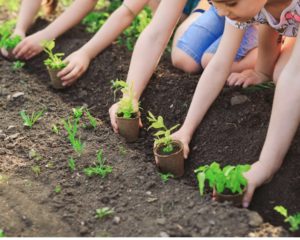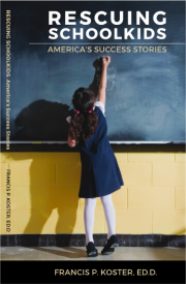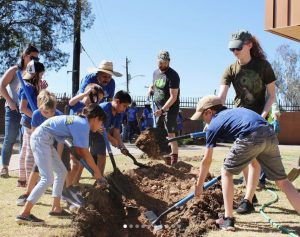Welcome to America's Optimistic futurist
Proven ways to improve kids' learning
without messing with teachers.

Need a Partner? Try the U.S. Department of Energy's Teaming Partner List
NEW Subscriber?
Find Past Newsletters of interest, below!
Newsletter of the Week
This week we offer one small, but significant, locally implementable solution that can help contribute to solving several issues challenging North Carolina schools.
North Carolina adolescents are in a tough place from a mental health perspective. There are several new phenomena happening to students in this age group, in addition to the complexities of puberty which many of us remember.
These include:
1) Climate Change: One study surveyed 10,000 young people (aged 16-25) and found that 59% were very or extremely worried about its impact on their life and the lives of their children. Forty-five percent said their feelings about climate change negatively affected their daily life and functioning, and they do not know what to do to head off the problem.[i]
2) Loss of Support Networks: There has been a significant decline in the strength of the social fabric which used to support youth, and provided psychological security through such things as club membership. One good example is membership in Boy and Girl Scouts’ programs, which has dropped 50% in 3 years, falling from 1.97 million in 2019 to about 1 million in 2022.[ii]
3) Covid: Covid has contributed to a growing adolescent sense of powerlessness both from the spread of the illness and disagreements about vaccination, which made different belief groups more visible.[iii] This was exacerbated by schools opening and closing in unpredictable ways and by the introduction of distance learning – despite lack of internet access among many of the most challenged.[iv]
4) Mental Health Issues: As a consequence of all of the above, mental illness and depression in K-12 students in North Carolina are skyrocketing. The 2023 Mental Health Association survey found that 11.5% of all American youth reported severe major depression.[v]
Because students feed powerless in all these cases, these four changes in the environment of our youth are significant contributors to the challenges of successfully managing a school.
When students feel depressed and powerless, they act out by:
- Resisting parental control
- Resisting others attempts to make them behave - including teachers
- Increasing attempts to control others, including joining groups or gangs that give them a sense of power and membership
- Seeking isolation and spending uncensored time in social media
What a mess. Our educators are being asked to deal with one of the most significant periods of social challenge in our lifetime.
What can a school do to increase mental health, teach students how to fight Climate Change, strengthen students’ sense of membership in society, increase student and school district academic performance and lower the school’s energy bills?
ONE ANSWER IS TO ORGANIZE AN EFFORT FOR STUDENTS TO PLANT TREES
(Best done in the Spring and Fall, which is why you are getting a newsletter about it now).
The kids love it. Here is a photo from a tree planting event which planted 31 trees on school grounds at Longview Elementary, in Phoenix, Arizona. [vi] Closer to home, Hurley Elementary School in Rowan-Salisbury School District planted 40 trees as part of the North Carolina Green Schools Program.[vii]
Can you sense the impact of this on the kids?
And for those who have to keep the school budget under control, planting trees has a number of benefits beside improving student grades and mental health. If they are planted on sunny sides of buildings, they lower spring and fall air conditioning energy costs. If planted near play areas, children are more inclined to be active, which stimulates their brains.
Independent of the benefits to school budgets, the rate of return on planting a tree in a public space is almost always higher than the costs. One study of five cities' costs and benefits found that, on a per-tree basis, tree planting accrued annual benefits ranging from about $1.50–$3.00 for every dollar invested.[viii]
 A simpler version of these projects is to have the students plant tiny trees in big pots, and nurture them for a year or more. This project can be done by younger children, who in following years can transplant their ‘babies’ into the ground. This lowers the cost of projects, as large trees are more expensive.
A simpler version of these projects is to have the students plant tiny trees in big pots, and nurture them for a year or more. This project can be done by younger children, who in following years can transplant their ‘babies’ into the ground. This lowers the cost of projects, as large trees are more expensive.
These efforts can be organized by mature volunteers who would love to work with youngsters outside. Just add that request to your school’s weekly emails to all students’ families, explaining the role, and asking for leadership, loaner shovels and garden hoses, and ask the Parents Organization to send the same email.
Can you see how this will address the four issues students are dealing with above?
Some educators have communicated to us that while some of the opportunities we have shared have great potential value to our state and country, they are beyond the allotted budget of a school. The job of schools, they say, is to educate our youth in classrooms – and our state’s ranking of 48th in the country for funding K-12 education (ix) makes it a challenge even to do inside-the-classroom education. They do not feel comfortable asking their already-stressed staff to take on projects like this.
Our reply is that a project like this, which will benefit the learning process, can be done by the school's Parents Association as a volunteer activity, and can be done without involving paid educators. Education World provides useful instruction about how to recruit potential volunteers like these.
The purpose of this newsletter is to make you aware of successful and replicable efforts outside the classroom that have improved North Carolina’s K-12 educational system.
As an educational leader, you can implement the above suggestions by sending out a call for volunteer parental leadership, granting permission to plant trees in specific locations. As your students’ mental health improves and their grades rise, your school ranking goes up along with local property values. For trivial cost, you have improved learning and quality of life.
I hope this seed sprouts!
------------------------------------------------------------
Potential Funding for Tree Planting
https://www.ncufc.org/legacy-tree-fund.php.
https://www.seedyourfuture.org/educator_grants
(This link connects you to dozens of potential funding sources for this kind of project.)
------------------------------------------------------------
----------------------------------------------------------------------------------
We are trying to grow the number of School Nurses who get our newsletters.
If you know such talented people, Subscribe a Friend!
FOOTNOTES
[1] https://www.thelancet.com/journals/lanplh/article/PIIS2542-5196(21)00278-3/fulltext
[2] https://www.nytimes.com/2021/07/01/us/boy-girl-scouts-membership-decrease-covid.html
[4] https://www.ncbroadband.gov/digital-divide/homework-gap/report/findings
[5] https://mhanational.org/issues/state-mental-health-america
[6] https://treesmatter.org/Trees-for-Schools
(9) https://edlawcenter.org/research/making-the-grade-2022.html
My books containing other success stories

Written in 2015, this was my first attempt at celebrating successful actions taken by K-12 schools. Although the data is now outdated, the 22 concepts in this book are still valid, and worth a read. The website above will continue to add to that library - look on the right side for more recent role model stories.

We are living in an era when many Americans feel things are out of their control, which causes them frustration, anger, and depression. This book explains the theory and practice of how to influence the direction and growth of your local economy, and regain your power to protect your community and family. First published in 2016, the lessons remain accurate and powerful.

As a country, we are not without solutions. This collection, first published in 2013, takes a country-wide locally solvable view of significant issues which still exist, and in may ways have gotten worse since I first wrote about them. You, can solve these problems by imitating the behavior of the pioneer efforts cited here.
Don’t miss out on new content
Stay up to date with the latest articles, news, or books.
Francis P. Koster Ed.D.
Proven local solutions to national problems.
CONTACT
Copyright © 2023 America's Optimistic Futurist
